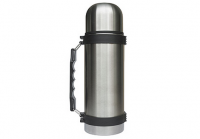








A vacuum flask (also known as a Dewar flask, Dewar bottle or Thermos) is an insulating storage vessel that greatly lengthens the time over which its contents remain hotter or cooler than the flask's surroundings.The vacuum flask consists of two flasks, placed one within the other and joined at the neck. The gap between the two flasks is partially evacuated of air, creating a near-vacuum which prevents heat transfer by conduction or convection.
The vacuum flask was designed and invented by Scottish scientist Sir James Dewar in 1892 as a result of his research in the field of cryogenics and is sometimes called a Dewar flask in his honor.
Dewar developed structural formulas for benzene (1867), did research in spectroscopy for more than 25 years, and by 1891 had constructed a machine for producing liquid oxygen in quantity. About 1892 he conceived the idea of using vacuum-jacketed vessels for the storage of low-temperature liquid gases, and the resulting device proved so efficient in preventing the influx of external heat that it became an essential tool in low-temperature scientific work. The principle of the Dewar flask has also been used extensively in the common thermos bottle. Dewar was subsequently the first to liquefy hydrogen gas (1898) and to solidify it (1899). He was knighted in 1904. His discovery (1905) that cooled charcoal can be used to help create high vacuums later proved useful in atomic physics. With Sir Frederick Augustus Abel he developed cordite, an explosive.